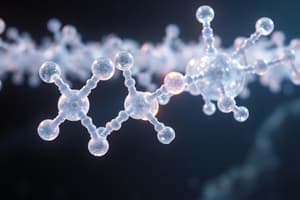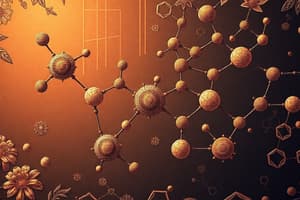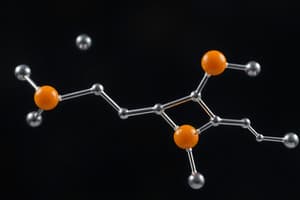Podcast
Questions and Answers
What structural characteristic defines a ketose?
What structural characteristic defines a ketose?
- A carbonyl group at the end of the carbon chain.
- A hydroxyl group above the plane of the sugar.
- A carbonyl group anywhere other than the end of the carbon chain. (correct)
- A branched structure with alpha 1-6 linkages.
How does the number of chiral carbons in a carbohydrate relate to the number of possible stereoisomers?
How does the number of chiral carbons in a carbohydrate relate to the number of possible stereoisomers?
- The number of stereoisomers is half the number of chiral carbons.
- The number of stereoisomers is the square of the number of chiral carbons.
- The number of stereoisomers is equal to the number of chiral carbons.
- The number of stereoisomers is calculated as $2^n$, where n is the number of chiral carbons. (correct)
What is the primary structural difference between amylose and amylopectin?
What is the primary structural difference between amylose and amylopectin?
- Amylose is a branched polysaccharide, while amylopectin is linear.
- Amylose is composed of fructose, while amylopectin is composed of glucose.
- Amylose is a linear polysaccharide, while amylopectin contains alpha 1-6 branches. (correct)
- Amylose contains beta 1-4 linkages, while amylopectin contains alpha 1-4 linkages.
What is the significance of non-reducing ends in glycogen?
What is the significance of non-reducing ends in glycogen?
Which of the following best describes mutarotation?
Which of the following best describes mutarotation?
What type of linkage is present in chitin and cellulose?
What type of linkage is present in chitin and cellulose?
Why can't humans digest beta 1-4 linkages found in cellulose?
Why can't humans digest beta 1-4 linkages found in cellulose?
What is the distinguishing feature of an anomeric carbon?
What is the distinguishing feature of an anomeric carbon?
During cyclization of a carbohydrate, what group attacks the carbonyl carbon?
During cyclization of a carbohydrate, what group attacks the carbonyl carbon?
If a carbohydrate has 3 chiral carbons, how many stereoisomers are possible?
If a carbohydrate has 3 chiral carbons, how many stereoisomers are possible?
What is the role of starch in plants?
What is the role of starch in plants?
In an aldose sugar, where is the carbonyl group located?
In an aldose sugar, where is the carbonyl group located?
What characterizes epimers?
What characterizes epimers?
How are glucose residues linked together in amylopectin?
How are glucose residues linked together in amylopectin?
What determines whether a sugar is classified as a D-sugar or an L-sugar?
What determines whether a sugar is classified as a D-sugar or an L-sugar?
How many residues between the alpha 1-6 branch points in amylopectin?
How many residues between the alpha 1-6 branch points in amylopectin?
Which of the following statements is true regarding alpha and beta isomers of glucose?
Which of the following statements is true regarding alpha and beta isomers of glucose?
Which carbon atom is the anomeric carbon in ketoses?
Which carbon atom is the anomeric carbon in ketoses?
Which polysaccharide has the highest frequency of branching?
Which polysaccharide has the highest frequency of branching?
What is a carbonyl carbon?
What is a carbonyl carbon?
For every one carbon molecule in a carbohydrate, how many water molecules are associated with it?
For every one carbon molecule in a carbohydrate, how many water molecules are associated with it?
Which of the following is a key characteristic that all carbohydrates share?
Which of the following is a key characteristic that all carbohydrates share?
What structural feature do both amylopectin and amylose share?
What structural feature do both amylopectin and amylose share?
What minimum number of carbon atoms are required for a carbohydrate to form cyclic structures?
What minimum number of carbon atoms are required for a carbohydrate to form cyclic structures?
In which form of glucose does the hydroxyl group project above the plane of the sugar?
In which form of glucose does the hydroxyl group project above the plane of the sugar?
What is always involved during cyclization?
What is always involved during cyclization?
What is the main chain and the branch point linkages in Glycogen?
What is the main chain and the branch point linkages in Glycogen?
Carbohydrates have many?
Carbohydrates have many?
How often is greater branching seen in glycogen?
How often is greater branching seen in glycogen?
Flashcards
Carbohydrates
Carbohydrates
Hydrates of carbon
Carbonyl carbon
Carbonyl carbon
Carbon with double-bonded oxygen.
Epimers
Epimers
Molecules differing in configuration at a single chiral carbon.
Ketose
Ketose
Signup and view all the flashcards
Aldose
Aldose
Signup and view all the flashcards
Anomeric carbon
Anomeric carbon
Signup and view all the flashcards
Beta isomer
Beta isomer
Signup and view all the flashcards
Alpha isomer
Alpha isomer
Signup and view all the flashcards
Mutarotation
Mutarotation
Signup and view all the flashcards
Starch
Starch
Signup and view all the flashcards
Amylose
Amylose
Signup and view all the flashcards
Amylopectin
Amylopectin
Signup and view all the flashcards
Glycogen
Glycogen
Signup and view all the flashcards
Non-reducing ends
Non-reducing ends
Signup and view all the flashcards
Chitin / Cellulose
Chitin / Cellulose
Signup and view all the flashcards
Study Notes
Sugars
- Carbohydrates are hydrates of carbon
- For every carbon molecule, there is one water molecule associated with it
- Carbohydrates have many chiral carbons
- Stereoisomer amount is calculated as 2^n, where n is the number of chiral carbons
- D or L sugar is based on the chiral carbon most distant from the carbonyl carbon
- Carbonyl carbon is a carbon with a double-bonded oxygen
- Epimers are two molecules differing in configuration at a single chiral carbon
- Ketose: carbonyl group is located anywhere other than the end of the chain
- Aldose: carbonyl group is located at the end of the chain
- Cyclic structures form with carbohydrates containing 5 or more carbons
- Cyclization happens when a hydroxyl group from within the sugar attacks the carbonyl carbon
- Cyclization always involves a carbonyl group
- Anomeric carbon is the carbon becoming chiral as a result of cyclization
- In aldoses, carbon 1 is anomeric
- In ketoses, carbon 2 is anomeric
- Alpha isomers: hydroxyl group below the plane of the sugar
- Beta isomers: hydroxyl group above the plane of the sugar
- Mutarotation: interconversion of alpha and beta forms through a cyclic intermediate
- Starch is used for energy storage within plants and is made of amylopectin and amylose
- Both amylopectin and amylose are homopolysaccharides
- Amylose is a linear homopolysaccharide of glucose joined by alpha 1-4 linkages
- Amylopectin: glucose residues linked by alpha 1-4 linkages, with alpha 1-6 branch points about every 25 residues
- Glycogen is a branched homopolysaccharide with alpha 1-4 main chain linkages and alpha 1-6 branch points
- Glycogen has a greater frequency of branching, about every 9 residues, which creates more non-reducing ends
- More non-reducing ends allow glucose stores to be mobilized faster
- Chitin and cellulose utilize beta 1-4 linkages to form elongated structures
- Humans cannot break down beta 1-4 linkages due to the lack of the necessary enzyme
Studying That Suits You
Use AI to generate personalized quizzes and flashcards to suit your learning preferences.




